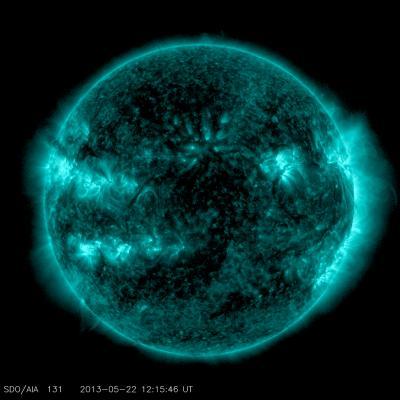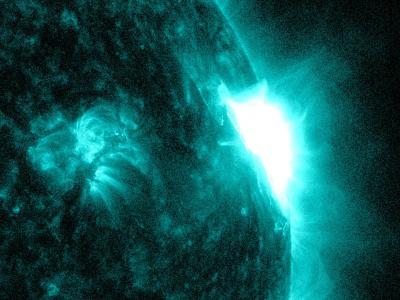The sun emitted a mid-level solar flare on the morning of May 22, 2013. The flare peaked at 9:38 a.m. EDT and was classified as an M7. M-class flares are the weakest flares that can still cause some space weather effects near Earth. In the past, they have caused brief radio blackouts at the poles.
Solar flares are powerful bursts of radiation. Harmful radiation from a flare cannot pass through Earth's atmosphere to physically affect humans on the ground, however -- when intense enough -- they can disturb the atmosphere in the layer where GPS and communications signals travel. This disrupts the radio signals for as long as the flare is ongoing, anywhere from minutes to hours.

These images of a solar flare were captured by NASA's Solar Dynamics Observatory on May 22, 2013. This image shows light in the 131 Angstrom wavelength, a wavelength that shows material heated to intense temperatures during a flare and that is typically colorized in teal.
(Photo Credit: NASA/SDO/GSFC)
Increased numbers of flares are quite common at the moment, since the sun's normal 11-year activity cycle is ramping up toward solar maximum, which is expected in late 2013. Humans have tracked this solar cycle continuously since it was discovered in 1843, and it is normal for there to be many flares a day during the sun's peak activity.
NOAA's Space Weather Prediction Center (http://swpc.noaa.gov) is the U.S. government's official source for space weather forecasts, alerts, watches and warnings. Updates will be provided as they are available on the flare and whether there was an associated coronal mass ejection or CME, another solar phenomenon that can send solar particles into space and affect electronic systems in satellites and on Earth.

NASA's Solar Dynamics Observatory captured this image of a solar flare on the right side of the sun on May 22, 2013. This image shows light in the 131 Angstrom wavelength, a wavelength that shows material heated to intense temperatures during a flare and that is typically colorized in teal.
(Photo Credit: NASA/SDO)
Source: NASA/Goddard Space Flight Center